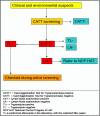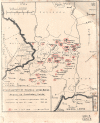Sleeping sickness in the historical focus of forested Guinea: update using a geographically based method
- PMID: 31599229
- PMCID: PMC6785972
- DOI: 10.1051/parasite/2019061
Sleeping sickness in the historical focus of forested Guinea: update using a geographically based method
Abstract
In 2017, 1447 new cases of Human African Trypanosomiasis (HAT) were reported, which reflects considerable progress towards the World Health Organisation's target of eliminating HAT as a public health problem by 2020. However, current epidemiological data are still lacking for a number of areas, including historical HAT foci. In order to update the HAT situation in the historical focus of forested Guinea, we implemented a geographically based methodology: Identification of Villages at Risk (IVR). The methodology is based on three sequential steps: Desk-based IVR (IVR-D), which selects villages at risk of HAT on the basis of HAT archives and geographical items; Field-based IVR (IVR-F), which consists in collecting additional epidemiological and geographical information in the field in villages at risk; and to be Medically surveyed IVR (IVR-M), a field data analysis through a Geographic Information System (GIS), to compile a list of the villages most at risk of HAT, suitable to guide active screening and passive surveillance. In an area of 2385 km2 with 1420,530 inhabitants distributed in 1884 settlements, 14 villages with a population of 11,236 inhabitants were identified as most at risk of HAT and selected for active screening. Although no HAT cases could be confirmed, subjects that had come into contact with Trypanosoma brucei gambiense were identified and two sentinel sites were chosen to implement passive surveillance. IVR, which could be applied to any gambiense areas where the situation needs to be clarified, could help to reach the objective of HAT elimination.
Title: Maladie du sommeil dans le foyer historique de Guinée forestière : actualisation grâce à une méthode géographique.
Abstract: En 2017, 1447 nouveaux cas de Trypanosomiase Humaine Africaine (THA) ont été rapportés, ce qui constitue une avancée importante pour atteindre l’objectif affiché par l’OMS d’éliminer la THA comme problème de santé publique d’ici 2020. Cependant, il existe toujours un manque d’informations épidémiologiques dans certaines zones, incluant des foyers historiques de THA. Afin d’actualiser la situation de la THA dans le foyer historique de Guinée forestière, nous avons appliqué une méthode géographique : l’Identification des Villages à Risque (IVR). La méthode s’effectue en 3 étapes successives : l’identification des villages à risque au bureau (IVR-D), qui sélectionne des villages à risque de THA sur la base d’archives de la THA et d’éléments géographiques ; l’identification des villages à risque sur le terrain (IVR-F), qui consiste à collecter des données épidémiologiques et géographiques des villages à risque sur le terrain ; l’identification des villages à risque à prospecter (IVR-M), une analyse des données de terrain, à travers un système d’information géographique, visant à dresser une liste de villages les plus à risque de THA, qui permettront d’orienter le dépistage actif et la surveillance passive. Dans une aire de 2385 km2, avec 1 420 530 habitants distribués dans 1884 peuplements, 14 villages d’une population de 11 236 habitants ont été identifiés comme les plus à risque de THA et sélectionnés pour un dépistage actif. Bien qu’aucun cas de THA n’ait été confirmé, des individus qui sont entrés en contact avec Trypanosoma brucei gambiense ont été identifiés et 2 sites sentinelles ont été retenus pour la surveillance passive. IVR, qui pourrait être appliquée dans n’importe quelle zone à gambiense où la situation nécessite d’être clarifiée, pourrait aider à atteindre l’objectif d’élimination de la THA.
Keywords: Elimination; Geography; Guinea; Risk; Sleeping sickness; Trypanosoma brucei gambiense.
© F. Courtin et al., published by EDP Sciences, 2019.
Figures





Similar articles
-
The elimination of human African trypanosomiasis: Monitoring progress towards the 2021-2030 WHO road map targets.PLoS Negl Trop Dis. 2024 Apr 16;18(4):e0012111. doi: 10.1371/journal.pntd.0012111. eCollection 2024 Apr. PLoS Negl Trop Dis. 2024. PMID: 38626188 Free PMC article.
-
Impact of the Ebola outbreak on Trypanosoma brucei gambiense infection medical activities in coastal Guinea, 2014-2015: A retrospective analysis from the Guinean national Human African Trypanosomiasis control program.PLoS Negl Trop Dis. 2017 Nov 13;11(11):e0006060. doi: 10.1371/journal.pntd.0006060. eCollection 2017 Nov. PLoS Negl Trop Dis. 2017. PMID: 29131822 Free PMC article.
-
Revisiting the immune trypanolysis test to optimise epidemiological surveillance and control of sleeping sickness in West Africa.PLoS Negl Trop Dis. 2010 Dec 21;4(12):e917. doi: 10.1371/journal.pntd.0000917. PLoS Negl Trop Dis. 2010. PMID: 21200417 Free PMC article.
-
Do Cryptic Reservoirs Threaten Gambiense-Sleeping Sickness Elimination?Trends Parasitol. 2018 Mar;34(3):197-207. doi: 10.1016/j.pt.2017.11.008. Epub 2018 Jan 23. Trends Parasitol. 2018. PMID: 29396200 Free PMC article. Review.
-
How can molecular diagnostics contribute to the elimination of human African trypanosomiasis?Expert Rev Mol Diagn. 2015 May;15(5):607-15. doi: 10.1586/14737159.2015.1027195. Epub 2015 Mar 18. Expert Rev Mol Diagn. 2015. PMID: 25786994 Review.
Cited by
-
Quality over quantity in active tick surveillance: Sentinel surveillance outperforms risk-based surveillance for tracking tick-borne disease emergence in southern Canada.Can Commun Dis Rep. 2023 Feb 1;49(2-3):50-58. eCollection 2023 Feb 1. Can Commun Dis Rep. 2023. PMID: 38090724 Free PMC article.
-
Criteria for selecting sentinel unit locations in a surveillance system for vector-borne disease: A decision tool.Front Public Health. 2022 Nov 10;10:1003949. doi: 10.3389/fpubh.2022.1003949. eCollection 2022. Front Public Health. 2022. PMID: 36438246 Free PMC article. Review.
-
Neglected tropical diseases in Republic of Guinea: disease endemicity, case burden and the road towards the 2030 target.Int Health. 2023 Sep 1;15(5):490-504. doi: 10.1093/inthealth/ihad036. Int Health. 2023. PMID: 37232124 Free PMC article. Review.
-
Towards the sustainable elimination of gambiense human African trypanosomiasis in Côte d'Ivoire using an integrated approach.PLoS Negl Trop Dis. 2023 Jul 31;17(7):e0011514. doi: 10.1371/journal.pntd.0011514. eCollection 2023 Jul. PLoS Negl Trop Dis. 2023. PMID: 37523361 Free PMC article.
-
The complex health seeking pathway of a human African trypanosomiasis patient in Côte d'Ivoire underlines the need of setting up passive surveillance systems.PLoS Negl Trop Dis. 2020 Sep 14;14(9):e0008588. doi: 10.1371/journal.pntd.0008588. eCollection 2020 Sep. PLoS Negl Trop Dis. 2020. PMID: 32925917 Free PMC article.
References
-
- Bidou J-E, Touré J-G. 2002. La population de la Guinée, dynamiques spatiales. Les Cahiers d’Outre-Mer, 217, 9–30.
-
- Camara O, Camara M, Lejon V, Ilboudo H, Sakande H, Leno M, Büscher P, Bucheton B, Jamonneau V. 2014. Immune trypanolysis test with blood spotted on filter paper for epidemiological surveillance of sleeping sickness. Tropical Medicine and International Health, 19, 828–831. - PubMed
-
- Courtin F, Jamonneau V, Duvallet G, Garcia A, Cuny G, Solano P. 2008. Sleeping sickness in West Africa (1906–2006): changes in spatial repartition and lessons from the past. Tropical Medicine and International Health, 13, 334–344. - PubMed
-
- Courtin F, Guengant J-P. 2011. One century of settlement in West Africa. Natures Sciences Sociétés, 19, 256–265.
MeSH terms
LinkOut - more resources
Full Text Sources
